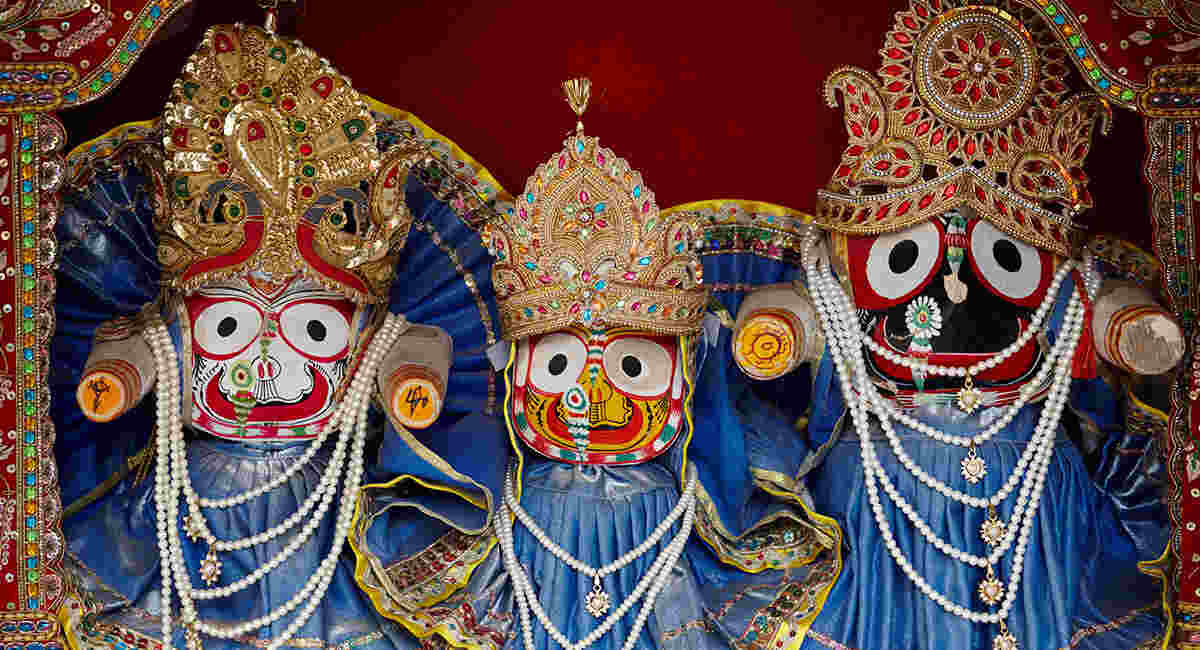The Metaphysical Masterpiece of Lord Krishna as Jagannatha
A deity with enormous round eyes, no visible neck, a smile frozen in eternal bliss, and an abstract form that breaks every stereotype of divine iconography. That is our Lord Jagannatha, the avant-garde, spiritual haute couture version of Lord Krishna himself. But why would the most charismatic, peacock-feathered, flute-playing god of Indian lore take on such an unorthodox, minimalist form? Fasten your seat belts; this is a journey into divine expression, metaphysical transformation, and soul-stirring symbolism.
Let’s start with a little context. The avatar, Lord Krishna of Lord Vishnu, is usually envisioned as a youthful, blue-skinned god with a smile that could melt the Himalayas and a dress sense that screams royal Boho meets celestial swag. But all that changes when he appears as Jagannatha, especially in the grand temple of Puri in Odisha. The limbs are stubby. The torso is a black, log-like structure. The face? Just two gigantic eyes and a smile that refuses to blink.
At first glance, it may seem like a cosmic glitch in divine design. But fashion, as you know, is not just about looking good; it’s about meaning, rebellion, and telling a story.
The roots of this transformation trace back to a soul-shaking episode after the Mahabharata war. Lord Krishna left his mortal body after fulfilling his earthly mission. People cremated his body, but the fire did not touch his heart. King Indradyumna discovered this divine relic when it floated to the shores of Puri after he was instructed in a dream to construct a temple and enshrine the sacred essence of Krishna in a new form.
Enter Viswakarma, the divine architect, who promised to carve the deities of Jagannatha, Balabhadra, and Subhadra from sacred neem logs. But there was a twist; the king did not disturb him while he worked. Curiosity, of course, got the better of Indradyumna, and he opened the door too soon. The deities were incomplete, but the divine voice declared them perfect.
Thus, the unique form of Lord Jagannatha is unfinished by human standards but complete in spiritual symbolism.
In the fashion world, less is more is a mantra. Jagannatha embodies this principle effortlessly. His seemingly unfinished body represents limitless divinity, formless yet all-forming. His large, round eyes symbolize eternal vigilance, the divine gaze that watches over all beings without blinking or judging. No hands? Because he holds the universe in his heart, not his palms. No feet? Because he’s already everywhere, omnipresent in the truest sense.
In this design, there’s no gold-plated drama or peacock-feather flamboyance. Instead, raw energy, stripped-down power, and a sense of godliness transcend flesh and ornamentation.
Let’s discuss the color palettes, which even the Met Gala can’t compete with. Jagannatha is painted black, the color of the cosmos – infinite, absorbing all, representing the mystery of creation. Balabhadra (his brother) is white, standing for purity and strength, and Subhadra (his sister) is yellow or red, showing fertility, power, and divine balance.
This trio represents a cosmic fashion editorial on the harmony of opposites. Masculine and feminine, chaos and order, form and formlessness, all stitched together in wood, cloth, and color.
Now, here’s the mic drop moment: Jagannatha’s form isn’t just a divine aesthetic, but radical inclusivity. In a world where gods often belonged to royal temples and elite castes, Jagannatha rolled out literally in a chariot to greet the people. That’s right – Rath Yatra is the divine runway show where God steps out to meet you, not the other way around.
In every sense, Jagannatha’s form breaks cultural, aesthetic, and spiritual barriers. He isn’t here just for royalty, priests, or scholars. He’s for everyone – the simple, the broken, the bold, and the beautiful.
So, why does Lord Krishna appear as Jagannatha? Because the divine doesn’t need to conform. Because authentic style lies in meaning, not perfection. Because transformation is the soul’s favorite accessory. Jagannatha is Krishna unfiltered, Krishna universal, Krishna reimagined for eternity.
Jagannatha reminds us that the truest form of divinity is unfinished, raw, honest, and inclusive in a world obsessed with filters, polish, and external beauty. He is the original disruptor of divine fashion, proving once and for all that spirituality and style are not just compatible; they’re cosmic soulmates.


